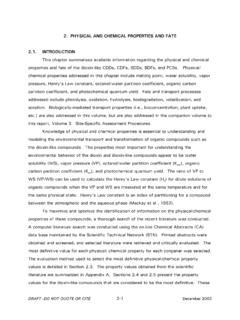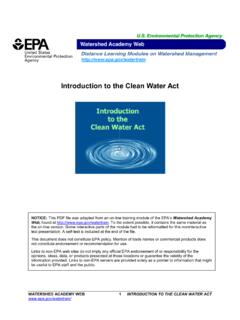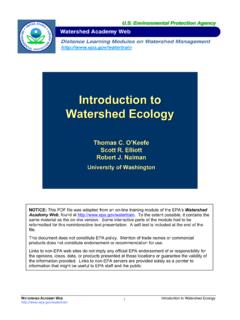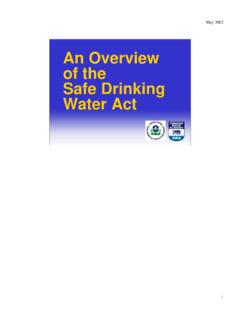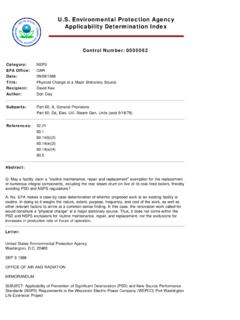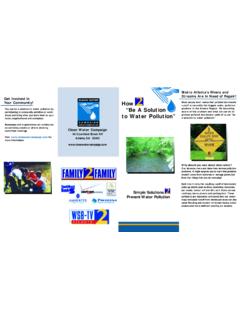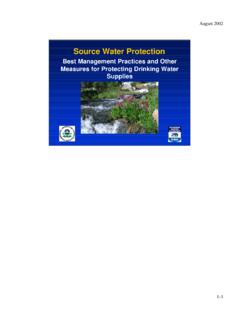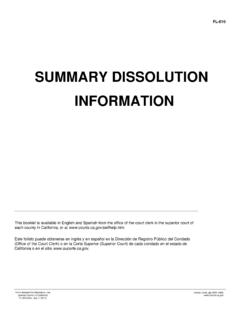Transcription of Arsenic, inorganic; CASRN 7440-38-2
1 Integrated Risk Information System (IRIS) Environmental Protection Agency Chemical Assessment summary National Center for Environmental Assessment 1 arsenic , inorganic; CASRN 7440-38-2 Human health assessment information on a chemical substance is included in the IRIS database only after a comprehensive review of toxicity data, as outlined in the IRIS assessment development process. Sections I (Health Hazard Assessments for Noncarcinogenic Effects) and II (Carcinogenicity Assessment for Lifetime Exposure) present the conclusions that were reached during the assessment development process. Supporting information and explanations of the methods used to derive the values given in IRIS are provided in the guidance documents located on the IRIS website.
2 STATUS OF DATA FOR arsenic , inorganic File First On-Line 02/10/1988 Category (section) Assessment Available? Last Revised Oral RfD ( ) yes 09/01/1991 Inhalation RfC ( ) not evaluated Carcinogenicity Assessment (II.) yes 06/01/1995 I. Chronic Health Hazard Assessments for Noncarcinogenic Effects Reference Dose for Chronic Oral Exposure (RfD) Substance Name arsenic , inorganic CASRN 7440-38-2 Last Revised 09/01/1991 The oral Reference Dose (RfD) is based on the assumption that thresholds exist for certain toxic effects such as cellular necrosis. It is expressed in units of mg/kg-day. In general, the RfD is an estimate (with uncertainty spanning perhaps an order of magnitude) of a daily exposure to the human population (including sensitive subgroups) that is likely to be without an appreciable risk of deleterious effects during a lifetime.
3 Please refer to the Background Document for an elaboration of these concepts. RfDs can also be derived for the noncarcinogenic health effects of substances that are also carcinogens. Therefore, it is essential to refer to other sources of information concerning the carcinogenicity of this Integrated Risk Information System (IRIS) Environmental Protection Agency Chemical Assessment summary National Center for Environmental Assessment 2 substance. If the EPA has evaluated this substance for potential human carcinogenicity, a summary of that evaluation will be contained in Section II of this file. NOTE: There was not a clear consensus among Agency scientists on the oral RfD. Applying the Agency's RfD methodology, strong scientific arguments can be made for various values within a factor of 2 or 3 of the currently recommended RfD value, , to ug/kg/day.
4 It should be noted, however, that the RfD methodology, by definition, yields a number with inherent uncertainty spanning perhaps an order of magnitude. New data that possibly impact on the recommended RfD for arsenic will be evaluated by the Work Group as it becomes available. Risk managers should recognize the considerable flexibility afforded them in formulating regulatory decisions when uncertainty and lack of clear consensus are taken into account. Oral RfD summary Critical Effect Experimental Doses* UF MF RfD Hyperpigmentation, keratosis and possible vascular complications Human Chronic oral exposure Tseng, 1977; Tseng et al., 1968 NOAEL: mg/L converted to mg/kg-day LOAEL: mg/L converted to mg/kg-day 3 1 3E-4 mg/kg-day *Conversion Factors -- NOAEL was based on an arithmetic mean of mg/L in a range of arsenic concentration of to mg/L.
5 This NOAEL also included estimation of arsenic from food. Since experimental data were missing, arsenic concentrations in sweet potatoes and rice were estimated as mg/day. Other assumptions included consumption of L water/day and 55 kg bw (Abernathy et al., 1989). NOAEL = [( mg/L x L/day) + mg/day] / 55 kg = mg/kg-day. The LOAEL dose was estimated using the same assumptions as the NOAEL starting with an arithmetic mean water concentration from Tseng (1977) of mg/L. LOAEL = [( mg/L x L/day) + mg/day] / 55 kg = mg/kg-day. Integrated Risk Information System (IRIS) Environmental Protection Agency Chemical Assessment summary National Center for Environmental Assessment 3 Principal and Supporting Studies (Oral RfD) Tseng, 1977.
6 Effects and dose-response relationships of skin cancer and blackfoot disease with arsenic . Environ. Health Perspect. 19: 109-119. Tseng, , Chu, How, Fong, Lin and S. Yeh. 1968. Prevalence of skin cancer in an endemic area of chronic arsenicism in Taiwan. J. Natl. Cancer Inst. 40: 453-463. The data reported in Tseng (1977) show an increased incidence of blackfoot disease that increases with age and dose. Blackfoot disease is a significant adverse effect. The prevalences (males and females combined) at the low dose are per 1000 for the 20-39 year group, per 1000 for the 40-59 year group, and per 1000 for the >60 year group. Moreover, the prevalence of blackfoot disease in each age group increases with increasing dose. However, a recent report indicates that it may not be strictly due to arsenic exposure (Lu, 1990).
7 The data in Tseng et al. (1968) also show increased incidences of hyperpigmentation and keratosis with age. The overall prevalences of hyperpigmentation and keratosis in the exposed groups are 184 and 71 per 1000, respectively. The text states that the incidence increases with dose, but data for the individual doses are not shown. These data show that the skin lesions are the more sensitive endpoint. The low dose in the Tseng (1977) study is considered a LOAEL. The control group described in Tseng et al. (1968; Table 3) shows no evidence of skin lesions and presumably blackfoot disease, although this latter point is not explicitly stated. This group is considered a NOAEL. The arithmetic mean of the arsenic concentration in the wells used by the individuals in the NOAEL group is 9 ug/L (range: 1-17 ug/L) (Abernathy et al.)
8 , 1989). The arithmetic mean of the arsenic concentration in the wells used by the individuals in the LOAEL group is 170 ug/L (Tseng, 1977; Figure 4). Using estimates provided by Abernathy et al. (1989), the NOAEL and LOAEL doses for both food and water are as follows: LOAEL - [170 ug/L x L/day + 2 ug/day (contribution of food)] x (1/55 kg) = 14 ug/kg/day; NOAEL - [9 ug/L x L/day + 2 ug/day (contribution of food)] x (1/55 kg) = ug/kg/day. Although the control group contained 2552 individuals, only 957 (approximately 38%) were older than 20, and only 431 (approximately 17%) were older than 40. The incidence of skin lesions increases sharply in individuals above 20; the incidence of blackfoot disease increases sharply in individuals above 40 (Tseng, 1968; Figures 5, 6 and 7).
9 This study is less powerful than it appears at first glance. However, it is certainly the most powerful study available on arsenic exposure to people. Integrated Risk Information System (IRIS) Environmental Protection Agency Chemical Assessment summary National Center for Environmental Assessment 4 This study shows an increase in skin lesions, 22% (64/296) at the high dose vs. (7/318) at the low dose. The average arsenic concentration in the wells at the high dose is 410 ug/L and at the low dose is 5 ug/L (Cebrian et al., 1983; Figure 2 and Table 1) or 7 ug/L (cited in the abstract). The average water consumption is L/day for males and L/day for females. There were about an equal number of males and females in the study. For the dose estimates given below we therefore assume an average of 3 L/day.
10 No data are given on the arsenic exposure from food or the body weight of the participants (we therefore assume 55 kg). The paper states that exposure times are directly related to chronological age in 75% of the cases. Approximately 35% of the participants in the study are more than 20 years old (Figure 1). Exposure estimates (water only) are: high dose - 410 ug/L x 3 L/day x (1/55 kg) = 22 ug/kg/day; low dose - 5 -7 ug/L x 3 L/day x (1/55 kg) = ug/kg/day. The high-dose group shows a clear increase in skin lesions and is therefore designated a LOAEL. There is some question whether the low dose is a NOAEL or a LOAEL since there is no way of knowing what the incidence of skin lesions would be in a group where the exposure to arsenic is zero. The incidence of skin lesions in the low-dose group is higher than that reported in the Tseng et al.
